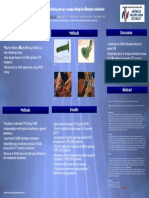VAMA Poster2
VAMA Poster2
Uploaded by
CEDIVA DeniaCopyright:
Available Formats
VAMA Poster2
VAMA Poster2
Uploaded by
CEDIVA DeniaCopyright
Available Formats
Share this document
Did you find this document useful?
Is this content inappropriate?
Copyright:
Available Formats
VAMA Poster2
VAMA Poster2
Uploaded by
CEDIVA DeniaCopyright:
Available Formats
The new VAMA® intubating airway: a unique design for fiberoptic intubation
Patricia Marzal, M.D.1, Francisca Llobell, M.D.1, Juan Cardona, M.D.1, Andres Madrid1, Valentin Madrid, M.D.1, Yvon F. Bryan, M.D.2*
1.Hospital G. U. Marina Alta, Denia (Alicante), Spain 2. Cincinnati Children’s Hospital Medical Center, Cincinnati, OH
Introduction Methods Discussion
•Lasermark on VAMA allowed clinician to
•Valentin Andres Madrid Airway (VAMA) is a Figure 1- Picture of VAMA with different views showing detachable piece and
orient FFB
lasermark
new intubating airway •Detachable piece of airway facilitated removal
•New design features of VAMA facilitate FFB of VAMA without accidental ETT removal
intubation •Intubating patient with VAMA •Further research required using VAMA in
•We present our initial experience using VAMA •Several views patients with difficult airways
airway –Insertion of VAMA alone in mouth
–FFB with ETT via VAMA
–Removal of detachable piece (pestana)
–Removal of entire VAMA
–[4 views displayed in quadrant form]
Abstract
Title: The new VAMA® intubating airway: a unique design for fiberoptic intubation
Authors: Marzal Patricia, Llobell Francisca, Cardona Juan, Madrid Andres, Madrid Valentin, Bryan
Yvon
Methods Results Introduction
Several available intubating airways facilitate performing fiberoptic intubation and placing an
endotracheal tube (1,2). The new VAMA intubating airway incorporates design features which
address common problems encountered during fiberoptic intubation. A line with an arrow (lasermark)
embedded on the distal part of the ventral surface of the posterior portion of the airway facilitates
•19 patients underwent FFB using VAMA •Age (mean and range) = 57.5 years (31-86) orientation (see Figure 1). A detachable piece on the proximal portion of the airway facilitates
removing the VAMA airway while the endotracheal tube (ETT) remains connected to the circuit; thus
•Awake/sedation with topical anesthesia or general •Time to intubation (mean,range) = 42 seconds avoiding interruption in ventilation and inadvertent extubation. We describe our experience with the
VAMA® intubating airway for fiberoptic intubation.
anesthesia (25-70) Methods
•Lasermark of VAMA facilitates orientation •Visualization of glottic opening on initial FFB After obtaining verbal consent, 19 patients undergoing surgery and requiring endotracheal (ETT)
intubation were recruited. After general anesthesia or sedation and topical anesthesia, a 5.5 mm flexible
introduction = 13/19 (68%) patients fiberscope was loaded with an ETT and placed orally via the VAMA® airway. Using lasermark on the
•Detachable piece facilitates removal of VAMA VAMA® for guidance, the FFB was inserted until the glottic opening was visible. After advancing the
FFB through the vocal chords, the ETT was railroaded into the trachea and the position was confirmed.
•Chin lift required for exposure of glottic opening
airway while ETT remains connected The detachable piece of the VAMA® was first removed and while holding the ETT, the remaining part
= 6/19 (32%) patients of the VAMA® airway was removed without disconnecting the ETT from circuit.
•Removal of VAMA does not interrupt ventilation or •Intubations on first attempt (one patient required Results
risk inadvertent extubation 3 attempts) = 18/19 (95%) patients The mean and range of age and time to intubation were 57.5 years (31-86) and 42 seconds (25-70). In
13 patients, the glottic opening was visualized on first pass of the FFB placed in the VAMA® airway.
In 6 patients, a chin lift exposed the glottic opening. All intubations occurred on first attempt, except
•5 patients with known difficult airways one which required three attempts. Five patients had known difficult airways (DA), 7 intubations were
awake and in 7 patients, paralytic agents were used. Discussion
•7 intubations performed awake/sedation, 7 The lasermark of the VAMA® airway helps identify the anatomical landmarks necessary for fiberoptic
intubation. Disconnecting the removable piece facilitates complete removal of the VAMA® airway.
intubations using paralytics Further research is required comparing to other intubating airways in patients with known DA’s who are
both awake and anesthetized.
References
1) J Clin Anesth 2004 16:66-73.
2) Anaesth 2004 59: 173–176.
3) VAMA Canula Package Insert www.ajlsa.com
*Wake Forest University Baptist Medical Center
You might also like
- Clinical Abstract Sample - Prac 2Document1 pageClinical Abstract Sample - Prac 2Andrea Diwa100% (2)
- EMD Guidecards PDFDocument49 pagesEMD Guidecards PDFЛизатро1980 ЛизаNo ratings yet
- VAMA Poster DefinitivoDocument1 pageVAMA Poster Definitivocedivadenia8084No ratings yet
- Update On Difficult Airway Management With A.10Document10 pagesUpdate On Difficult Airway Management With A.10Minaz PatelNo ratings yet
- Applsci 10 02429 PDFDocument9 pagesApplsci 10 02429 PDFAayush Kumar KumarNo ratings yet
- Fractal Antenna Concept & Applications: Faculty of Electronics Ce DepartmentDocument22 pagesFractal Antenna Concept & Applications: Faculty of Electronics Ce DepartmentPraveen KumarNo ratings yet
- Belimo VAV-Compact 1 0 enDocument48 pagesBelimo VAV-Compact 1 0 ensheik.rasith.anvarNo ratings yet
- Video Chapter 1 - Antenna ParametersDocument12 pagesVideo Chapter 1 - Antenna Parametersnorfatin fadzlinda nordinNo ratings yet
- MyFAST 4.0 150m3 DanDocument8 pagesMyFAST 4.0 150m3 DandkdavorkalcNo ratings yet
- Design and Application of A Compact Uwb Antipodal Vivaldi AntennaDocument5 pagesDesign and Application of A Compact Uwb Antipodal Vivaldi AntennaAnnisa SalsabellaNo ratings yet
- Ultra Wideband Antenna With WLAN Band-Notch Characteristic: September 2013Document6 pagesUltra Wideband Antenna With WLAN Band-Notch Characteristic: September 2013Engr Kashi YousafzaiNo ratings yet
- 2020PhysicsofFluids BnfreeDocument29 pages2020PhysicsofFluids BnfreePDPOrieza SatifaNo ratings yet
- Vyr Int 1900003 Bellavista 1000 TechspecsDocument16 pagesVyr Int 1900003 Bellavista 1000 Techspecshüseyin vururNo ratings yet
- Airway Management MindmapDocument1 pageAirway Management Mindmapmohamed mowafeyNo ratings yet
- AintreeDocument1 pageAintreeIrene CristinaNo ratings yet
- 920 FullDocument13 pages920 FullmiminNo ratings yet
- IET Microwaves Antenna Prop - 2022 - Gonçalves Licursi de Mello - The Bow Tie Antenna Performance Limitations andDocument12 pagesIET Microwaves Antenna Prop - 2022 - Gonçalves Licursi de Mello - The Bow Tie Antenna Performance Limitations andharshn2020No ratings yet
- Full-Space Scanning Periodic Phase-Reversal Leaky-Wave AntennaDocument15 pagesFull-Space Scanning Periodic Phase-Reversal Leaky-Wave AntennaJojo NamNo ratings yet
- Summary of 2022 ASA Guidelines For Management of The Difficult Airway - André FerreiraDocument10 pagesSummary of 2022 ASA Guidelines For Management of The Difficult Airway - André FerreiracedivadeniaNo ratings yet
- Reference 1 PDFDocument10 pagesReference 1 PDFYounas KhanNo ratings yet
- A Dual Band 4 Element Cubical Quad AntennaDocument15 pagesA Dual Band 4 Element Cubical Quad Antennaadel agustiNo ratings yet
- 2012 UWB Radar System IMSDocument5 pages2012 UWB Radar System IMSShayan aminNo ratings yet
- CEDIVA Dénia, Training Center in Difficult Airway ManagementDocument29 pagesCEDIVA Dénia, Training Center in Difficult Airway ManagementCEDIVA DeniaNo ratings yet
- P10120en2109 Ventilation Info-1Document8 pagesP10120en2109 Ventilation Info-1Salman SaeedNo ratings yet
- VESDA Model Comparison ChartDocument2 pagesVESDA Model Comparison ChartANDREINo ratings yet
- CPC Aseptic ConnectionsDocument7 pagesCPC Aseptic ConnectionsMochammad RezaNo ratings yet
- Drexelbrook Product Selection Guide Continuous Level ProductsDocument2 pagesDrexelbrook Product Selection Guide Continuous Level Productszeeshan_iraniNo ratings yet
- Peripheral Interventions: Product Catalogue Produktkatalog Catálogo de ProductosDocument152 pagesPeripheral Interventions: Product Catalogue Produktkatalog Catálogo de ProductosCampaign MediaNo ratings yet
- TJF Q290VDocument6 pagesTJF Q290Vlied cnNo ratings yet
- Vyr Int 1900001 Bellavista 1000e TechspecsDocument16 pagesVyr Int 1900001 Bellavista 1000e Techspecshüseyin vururNo ratings yet
- Standardization of 4-20ma Signal Levels - InstrulearningDocument1 pageStandardization of 4-20ma Signal Levels - Instrulearningabhi nikNo ratings yet
- AMO Phaco CatalogDocument7 pagesAMO Phaco Catalogaurora. guoNo ratings yet
- Avalus Interactive Deck - Version 2Document60 pagesAvalus Interactive Deck - Version 2irmelodyNo ratings yet
- Universal Optical Splice Enclosures (OSE) : Features and BenefitsDocument4 pagesUniversal Optical Splice Enclosures (OSE) : Features and BenefitsSergio Denis UCNo ratings yet
- BeneVision-TM80-BrochureDocument4 pagesBeneVision-TM80-BrochureRespicare ServiceIT MikeNo ratings yet
- NTSP Paediatric Bedhead Signs Templates To AdaptDocument4 pagesNTSP Paediatric Bedhead Signs Templates To AdaptDaniela MeliánNo ratings yet
- Suzan EucapDocument6 pagesSuzan EucapFarhan LabibNo ratings yet
- Sat Tvro SystemDocument1 pageSat Tvro SystemmishaNo ratings yet
- Corning Fiber Optic Cable Access ToolsDocument4 pagesCorning Fiber Optic Cable Access ToolscolinyNo ratings yet
- September 2014 Ophthalmic PearlsDocument2 pagesSeptember 2014 Ophthalmic PearlsPutri dwiyantiNo ratings yet
- Advances in Massive MIMO Antenna Design A ReviewDocument2 pagesAdvances in Massive MIMO Antenna Design A ReviewJaiverdhan100% (1)
- Plastic and Reconstructive Surgery - February 2022Document2 pagesPlastic and Reconstructive Surgery - February 2022Hannah HolandaNo ratings yet
- Tube Inspection Probe Catalogue EN 201204 PDFDocument52 pagesTube Inspection Probe Catalogue EN 201204 PDFIrawan EkklesiaNo ratings yet
- CFD Workshop Plan - TaggedDocument3 pagesCFD Workshop Plan - Taggedamaar azamNo ratings yet
- Case Report Hofmann2014Document5 pagesCase Report Hofmann2014Nurul FahmiNo ratings yet
- RFQ - MV Panel Installations (Make - Al Fanar), G& T and VLF TestingDocument1 pageRFQ - MV Panel Installations (Make - Al Fanar), G& T and VLF Testingmoosa ibrahaimNo ratings yet
- 4-Horn Monopulse FeedDocument5 pages4-Horn Monopulse FeedJack CharityNo ratings yet
- Cobham Microwave Antennas Antenna CatalogueDocument77 pagesCobham Microwave Antennas Antenna CatalogueJorge Mauricio Pi LucoNo ratings yet
- Neov 1940Document2 pagesNeov 1940N dasNo ratings yet
- Design of Rectangular Microstrip Patch Antenna: March 2016Document7 pagesDesign of Rectangular Microstrip Patch Antenna: March 2016Fadi AlsaoorNo ratings yet
- EMSpringerDocument12 pagesEMSpringerDomRuanNo ratings yet
- The Laryngeal Mask Airway: Technical Guidelines and Use in Special SituationsDocument10 pagesThe Laryngeal Mask Airway: Technical Guidelines and Use in Special Situationsjangkrik21No ratings yet
- Ventilador Mekics PDFDocument4 pagesVentilador Mekics PDFBalam CaballeroNo ratings yet
- High Gain Beam Scanning Antenna Based On Siw Resonator Te440 ModeDocument3 pagesHigh Gain Beam Scanning Antenna Based On Siw Resonator Te440 ModeShaik KareemullaNo ratings yet
- BR Instrumentposter-2c 90092905 20211208 enDocument1 pageBR Instrumentposter-2c 90092905 20211208 enOmar SaaedNo ratings yet
- Passy-Muir Valves, Accessories, & Connections GuideDocument2 pagesPassy-Muir Valves, Accessories, & Connections GuideCristian AcostaNo ratings yet
- Nassar 2015Document5 pagesNassar 2015johangqaNo ratings yet
- LG Cassette AC CatalogueDocument3 pagesLG Cassette AC CatalogueGENESIS INTERNATIONAL INVESTMENT LLC100% (1)
- First-Order Theorem Proving and V: AmpireDocument35 pagesFirst-Order Theorem Proving and V: AmpireRichard LawsonNo ratings yet
- Bio 120 Group 3 Concept MapDocument1 pageBio 120 Group 3 Concept MaprufodexNo ratings yet
- g5 Medical Devices Vibracare Operating ManualDocument2 pagesg5 Medical Devices Vibracare Operating ManualFélix HernándezNo ratings yet
- Clinical Competence in The Performance of Fiberoptic Laryngoscopy and Endotracheal IntubationDocument6 pagesClinical Competence in The Performance of Fiberoptic Laryngoscopy and Endotracheal IntubationCEDIVA DeniaNo ratings yet
- Continuous Airway Access For The Difficult.30Document6 pagesContinuous Airway Access For The Difficult.30CEDIVA DeniaNo ratings yet
- FINAL September 2010 Gazette (Reduced Size)Document16 pagesFINAL September 2010 Gazette (Reduced Size)cedivadenia8084No ratings yet
- Protocolo Extubacion H.dénia.2015Document1 pageProtocolo Extubacion H.dénia.2015CEDIVA DeniaNo ratings yet
- Permanent Center Project in Denia Hospital Cediva Denia Spain 2010 PDFDocument10 pagesPermanent Center Project in Denia Hospital Cediva Denia Spain 2010 PDFCEDIVA DeniaNo ratings yet
- Extubation - Protocol - Poster (1) WITH PICTURES v2Document1 pageExtubation - Protocol - Poster (1) WITH PICTURES v2CEDIVA DeniaNo ratings yet
- I Symposium On Difficult Airway ManagementDocument3 pagesI Symposium On Difficult Airway ManagementCEDIVA DeniaNo ratings yet
- Picture From Cediva Denia-Anesthesia Icu DepartmentDocument1 pagePicture From Cediva Denia-Anesthesia Icu DepartmentCEDIVA DeniaNo ratings yet
- CEDIVA Dénia, Training Center in Difficult Airway ManagementDocument29 pagesCEDIVA Dénia, Training Center in Difficult Airway ManagementCEDIVA DeniaNo ratings yet
- AristotelesDocument1 pageAristotelesCEDIVA DeniaNo ratings yet
- German Guidelines For DamDocument22 pagesGerman Guidelines For DamCEDIVA Denia100% (1)
- 19ap6 Refer en CIA Poster en EsaDocument2 pages19ap6 Refer en CIA Poster en EsaCEDIVA DeniaNo ratings yet
- Spu Puskesmas 1Document12 pagesSpu Puskesmas 1Lita OktarinaNo ratings yet
- Baseline and Endline ReportDocument7 pagesBaseline and Endline ReportJohn Paul DioneoNo ratings yet
- School Clinic Visit Form: Wakat National High School Wakat, Barobo, SDSDocument1 pageSchool Clinic Visit Form: Wakat National High School Wakat, Barobo, SDSAivee Tigol Judilla GulleNo ratings yet
- Homeo First Aid BookDocument8 pagesHomeo First Aid BookavidmasterNo ratings yet
- Man Transforming Into Wolf A Rare Case of ClinicalDocument3 pagesMan Transforming Into Wolf A Rare Case of Clinicalruben jaenNo ratings yet
- Dryneedling-Pak Boss CuncunDocument32 pagesDryneedling-Pak Boss CuncunMuhamad BenyaminNo ratings yet
- Approach To AtaxiaDocument6 pagesApproach To AtaxiaVivek KumarNo ratings yet
- Stroke Scale PDF 2 PDFDocument2 pagesStroke Scale PDF 2 PDFSisca Chearz100% (1)
- OET Practice Writing TestDocument2 pagesOET Practice Writing TestyazzNo ratings yet
- DrugDocument15 pagesDrugknxdg86vk2No ratings yet
- Flowchart For Assessing Illness in The Absence of The School NurseDocument1 pageFlowchart For Assessing Illness in The Absence of The School Nurserahkelp100% (1)
- Januari Sakit 2019Document301 pagesJanuari Sakit 2019Kedhy Tiger JaillNo ratings yet
- Cefalea Postpuncion Lumbar INFOGRAFIA 2024Document3 pagesCefalea Postpuncion Lumbar INFOGRAFIA 2024Alejandro AlonsoNo ratings yet
- Orofacial PainDocument7 pagesOrofacial PainAkram AlsharaeeNo ratings yet
- The Neuralgias Diagnosis and Management Curr Neurol Neurosci Rep 2014Document8 pagesThe Neuralgias Diagnosis and Management Curr Neurol Neurosci Rep 2014Fernando BravoNo ratings yet
- Review of Systems Template 01 1Document6 pagesReview of Systems Template 01 1auraester.sionillo-18No ratings yet
- IBSDocument28 pagesIBSRdindaaNo ratings yet
- MucostaDocument3 pagesMucostaJessica DensingNo ratings yet
- Modified Glasgow Coma Scale For Infants and ChildrenDocument1 pageModified Glasgow Coma Scale For Infants and ChildrenYudha Perwira PutraNo ratings yet
- 1.1 BackgroundDocument14 pages1.1 BackgroundDwi WulandariNo ratings yet
- At The Doctor's PDF Learning Arabic With AngelaDocument21 pagesAt The Doctor's PDF Learning Arabic With AngelaKonul Sadiqova100% (1)
- Fisiopatologia Do Ponto GatilhoDocument3 pagesFisiopatologia Do Ponto GatilhoAndréLuisVargasNo ratings yet
- Febrile Convulsion - SeizuresDocument20 pagesFebrile Convulsion - Seizuressai saiNo ratings yet
- AY 2023 Sem 1 A371 IS05 Lecture - StudentDocument62 pagesAY 2023 Sem 1 A371 IS05 Lecture - Student65scgdwmbkNo ratings yet
- Typical Signs and Symptoms of Psychiatric IllnessesDocument52 pagesTypical Signs and Symptoms of Psychiatric IllnessesmejammbatoonNo ratings yet
- Somatoform Disorders Power PointDocument15 pagesSomatoform Disorders Power Pointwe sagara dewiNo ratings yet
- Observation Reporting and Documentation 1Document25 pagesObservation Reporting and Documentation 1batononjennyNo ratings yet
- Ban Xia Bai Zhu Tian Ma TangDocument14 pagesBan Xia Bai Zhu Tian Ma TangHung NguyenNo ratings yet




































































































